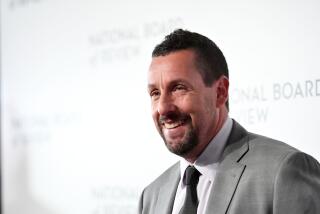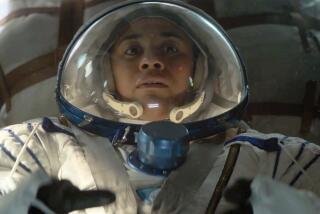Bloody movies needn’t be black and white
MEL GIBSON began his film career playing a character named Scollop in a minor league surfing thriller known both as “Summer City” and “Coast of Terror.” Clint Eastwood’s beginnings -- films like “Revenge of the Creature” and “Francis in the Navy” -- were equally humble. Now both men have become powerful and successful film directors, with violence the inescapable central element of their cinematic style.
Gibson’s and Eastwood’s lifelong connection to violence as subject matter, both as actors and directors, comes from a variety of factors -- from the demands of the marketplace to personal preference to the fact that violence, going back to the Bible and beyond, is a subject that has always had a fascination for humanity. It has always been with us -- perhaps never more than in times of war -- and likely always will.
But not only do the directors take opposite approaches to the act of putting violence on screen, they increasingly differ in their point of view on the subject. These differences are especially apparent right now, when both men, Gibson with “Apocalypto” and Eastwood with “Flags of Our Fathers” and the forthcoming “Letters From Iwo Jima,” have films in release that put brutal imagery front and center.
In “Apocalypto,” Gibson depicts Maya culture at its corrupt nadir with over-the-top scenes of animal slaughter, human beheadings and extreme uses of cruelty. Eastwood’s films are bookend stories of the battle between Japanese and American forces at Iwo Jima, with massive carnage rendered sparingly in black and white rather than the dramatic primary colors of Gibson’s palette.
In a time when movies are more often produced by committee, Gibson and Eastwood both have the ability to make their films exactly the way they want them, to in effect have the freedom of independent directors though they are working with the larger budgets of Hollywood. Eastwood owes his independence to the great respect he’s earned with his long career as a director and star, while Gibson’s is a result of the financial windfall “The Passion of the Christ” provided.
Eastwood’s characters have often been at home in a brutal and unbending world, starting with the Man With No Name character in the westerns of Sergio Leone (“A Fistful of Dollars,” “For a Few Dollars More,” “The Good, the Bad and the Ugly”). These tendencies reached their peak in the “Dirty Harry” films, which detailed the exploits of rule-bending San Francisco police inspector Harry Callahan. Most famously, in “Sudden Impact,” the fourth film in the series, Callahan dares a malefactor to do his worst with the famous line “Go ahead. Make my day.”
Yet in retrospect, there was rarely the sense with Eastwood’s characters that they had an unhealthy, unquenchable lust for violence. Rather it was that brutality was simply the most effective tool for the job at hand -- a theme underscored in both “Flags” and “Letters.”
With Gibson’s characters, it’s more often the reverse that is true.
Though Gibson played violent men as early as 1979’s “Mad Max,” his voracious taste for it did not truly manifest itself until he became a director. The gory “Braveheart” became the first film to win the best picture Oscar with a hero who is graphically drawn and quartered, and it was not the end of things.
In fact, many of the films Gibson had a hand in, either as star or director, showed an almost sadistic taste for on-screen violence. At the release of 1999’s “Payback,” for instance, a film where, among other things, Gibson’s character gets his toes crushed, one critic (that would be me) wrote “to be entertained by ‘Payback’ you have to be willing to endure the agonizing beatings and torture it inflicts on its characters.”
Things got worse, quite successfully so, with “The Passion of the Christ.”
At the time, in examining just one aspect of the film’s intense violence, my review noted: “This is no ordinary movie flogging, this is an unspeakably savage, unrelenting real-time beating, first with a cane, then with an especially barbarous instrument the press material identifies as ‘a flagrum, or “the cat o’ nine tails,” a whip designed with multiple straps and embedded with barbed metal tips to catch and shred the skin and cause considerable blood loss.’ All of which is shown in a kind of horrific detail that would be unthinkable in a film that could not claim the kind of religious connection this one does.”
“Apocalypto,” with its pagan battles, graphic beheadings and hearts pulled still-beating from corpses, shows that Gibson’s zeal to be as in your face with mayhem as modern technology allows is in no danger of disappearing.
With Eastwood, interestingly enough, the opposite has happened.
Eastwood, of course, is also dealing with graphic violence as much as ever. But his matter-of-fact use of it on screen is much more restrained, not only compared with Gibson’s but compared with the films he used to star in.
That restraint is particularly evident in “Letters,” in which the camera rarely lingers on the broken bodies of fallen soldiers, opting instead to capture the fear, frustration and boredom of war as played out across the actors’ faces.
Eastwood has an unblinking attitude in the face of horror that is more suited to reflection than to being something an action junkie is going to get off on.
More than that, many of Eastwood’s films, starting really with “Unforgiven,” are focused on the question of the very necessity of violence, on the sense that there must be a better way coupled with the anguished realization that human beings can’t seem to find it.
It’s a personal and professional journey that does the filmmaker great credit, and one that Gibson, if we are to judge by “Apocalypto,” is not yet ready to make.
Turan is a Times film critic.
More to Read
Only good movies
Get the Indie Focus newsletter, Mark Olsen's weekly guide to the world of cinema.
You may occasionally receive promotional content from the Los Angeles Times.







